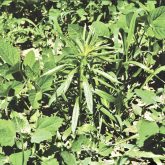Glyphosate-resistant Canada fleabane is found in 30 counties across Ontario and can cause yield losses exceeding 50 per cent in both corn and soybeans. Since there are only a few other herbicides that are effective at controlling it, this glyphosate-resistant weed has been one of the most troublesome weeds in Ontario. So, what if you could reverse the mechanism of resistance?
Well, that is the concept behind my M.Sc. (Master’s) research project, in collaboration with Dr. François Tardif and Dr. Clarence Swanton at the University of Guelph, and Dr. Eric Page with Agriculture and Agri-Food Canada.
Read Also

Agronomists share tips for evaluating new crop products and tech: Pt. 3
With new products, new production practices and new technology converging on the agriculture industry at a frenetic pace in recent…
To understand my project a bit better, it is important to know that weeds become herbicide resistant either by target site or non-target site resistance mechanisms.
When glyphosate enters a susceptible plant, it moves to the target site (in the chloroplasts) and disrupts normal plant function, causing plant death. Target site resistance occurs when that target site is altered to a point where glyphosate is no longer effective. By contrast, non-target site resistance involves mechanisms that reduce the amount of glyphosate that reaches the target site, thereby allowing survival of the plant.
In Canada fleabane, it had been thought that non-target site resistance was the only mechanism responsible for the glyphosate-resistant plants found. However, it was recently discovered that target site resistance is the main culprit.
Complicating matters, there is disagreement as to whether target site resistance alone causes the level of resistance seen in Canada fleabane. Therefore, it is speculated that target and non-target site resistance mechanisms are working together to cause a higher level of resistance.
My research will aim at reversing non-target site resistance in Canada fleabane with the use of glycine, a common amino acid known to compete with glyphosate when taken up by the vacuole (a plant cell organelle). If the two resistance mechanisms are actually working together within a plant, glycine may be able to reduce the non-target site resistance to a point where the target site resistance mechanism is not enough to counteract the effects of glyphosate. This should cause the plant to become susceptible and die when glyphosate is applied.
To help visualize this concept, think of the vacuole as a balloon that is contained within a two-litre pop bottle. You can fill the balloon to a certain point, but it will eventually reach a limit and will not burst because the bottle (representing the plant cell wall) provides structural support. If a mixture of glyphosate and glycine filled the vacuole, theoretically, there would be an overflow that could allow glyphosate to reach the chloroplasts and kill the plant as intended.
To test this theory, growth chamber experiments (see photo at top) and possibly field trials will be conducted. In the end, a better understanding of how Canada fleabane resists glyphosate could lead to a new management practice that reverses the mechanism of resistance, allowing better control of this weed.
Have a question you want answered? Hashtag #PestPatrol on Twitter to @cowbrough or email Mike at [email protected].















